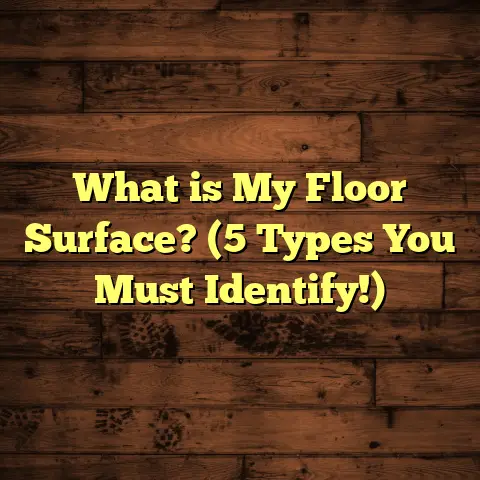What Is In-Floor Radiant Heat? (5 Benefits Explained!)
What Is In-Floor Radiant Heat?
Let me tell you, one of the things I love most about in-floor radiant heat is its incredible adaptability. Whether I’m working on a small bathroom renovation or a sprawling new home build, this system always seems to fit perfectly. But what exactly is in-floor radiant heat? How does it work, and why do so many people—including myself—recommend it?
In-floor radiant heat is a heating system that’s installed underneath your floor surface. Instead of pushing hot air into the room like traditional heaters, radiant heating gently warms the floor itself. This warmth then radiates upward, evenly heating everything in the space—your feet, furniture, walls—everything. It’s like having a warm blanket spread across your entire floor.
When I first saw radiant floor heating in action years ago, I was surprised by how quiet and comfortable it was. The homeowners had replaced their noisy forced-air furnace with this system and reported feeling warmer while actually using less energy. Since then, I’ve installed hundreds of these systems and learned a lot—not just about how they work but about how they change the way people experience their homes.
How Does In-Floor Radiant Heat Actually Work?
There are two main types of in-floor radiant heat systems: electric and hydronic. Each has its own pros and cons depending on your needs and budget.
Electric Radiant Systems
Electric systems use thin electric heating cables or mats placed beneath the floor covering. When electricity flows through these cables, they generate heat that warms the floor above. These systems are usually easier and cheaper to install for smaller areas like bathrooms or kitchens.
Electric radiant heat is often installed under tile or stone floors because those materials conduct heat well. It’s also great for retrofit projects because it requires less invasive installation compared to hydronic systems.
Hydronic Radiant Systems
Hydronic systems use warm water circulated through flexible plastic tubing embedded in the floor slab or subfloor. The water is heated by a boiler or water heater and pumped through loops under the floor.
These systems are typically more energy-efficient for heating larger spaces since water holds heat longer than air or electric cables. They can be connected to various heat sources, including gas boilers, solar water heaters, or even geothermal systems.
One of my favorite projects involved installing a hydronic system in a 3,000-square-foot house in Maine. The family had switched from an old oil furnace to radiant floor heating paired with a high-efficiency gas boiler. By the end of the first winter, their energy bills were down over 30%, and they said their home felt like a cozy retreat even on the coldest days.
Why Do People Choose Radiant Floor Heating?
I often get asked why someone would pick radiant floor heat over traditional heating methods. Sure, forced-air systems are familiar and easy to understand. But when you feel the difference radiant heat makes, it’s clear why it’s gaining popularity.
Here are some reasons I hear most from my clients:
- Comfort: Radiant heat warms your body and objects directly without blowing cold air around.
- Energy Savings: You can keep your thermostat lower because radiant heat feels warmer at lower temperatures.
- Quiet Operation: No noisy fans or blowers—just peaceful warmth.
- Better Air Quality: No circulating dust or allergens.
- Design Flexibility: No need for radiators or vents, freeing wall space.
I’ll get into these benefits more deeply below because they really highlight why radiant floor heating is special.
5 Benefits of In-Floor Radiant Heat Explained
1. Ultimate Comfort That Feels Natural
Let’s talk comfort first because that’s what really sold me on radiant heat years ago.
Have you ever stepped barefoot on cold tile first thing in the morning? It’s an unpleasant shock—something I used to hear all the time from clients before installing radiant systems.
Radiant floor heating eliminates that problem by warming the floor surface itself, so when you step down, it feels pleasantly warm. Because the heat radiates upwards evenly, you don’t get those annoying hot or cold spots common with forced-air systems.
I remember one client who told me their kids used to hate mornings because of cold floors. After installing radiant heat beneath their kitchen tiles, they said breakfast time became so much more enjoyable—the kids even wanted to eat breakfast there more often!
The warmth also penetrates furniture and walls gently, creating an all-around cozy atmosphere that feels very natural compared to the dry blast of hot air from vents.
2. Energy Efficiency That Pays Off
Heating costs can be a headache, especially during brutal winters. One thing I learned early on is that radiant heat can save significant money over time.
Why? Because it heats people and objects rather than just air. This means you can keep your thermostat set 2-3 degrees lower but still feel just as warm.
According to data from the U.S. Department of Energy, homes with radiant floor heating can use up to 30% less energy compared to traditional forced-air heating systems.
In one project I managed in Minnesota, a family replaced their baseboard heaters with hydronic radiant floors. Their first winter bills dropped by nearly 25%. That’s not small change when you’re dealing with harsh winters!
Plus, hydronic systems can be paired with energy-efficient boilers or renewable energy sources like solar thermal collectors for even more savings.
3. Cleaner Air = Healthier Home
If allergies or respiratory issues run in your family, this benefit alone might convince you.
Forced-air heating moves dust, pollen, pet dander, and other allergens around your home every time the system kicks on. I’ve seen firsthand how this aggravates people’s asthma or allergies during winter months when windows stay closed.
Radiant floor heat doesn’t rely on moving air—it simply radiates warmth silently through floors. This greatly reduces airborne dust and allergens circulating indoors.
One client with severe allergies told me radiant floors made a huge difference for her family’s health. She noticed fewer asthma attacks and less congestion during winter after switching from forced air.
4. Minimal Maintenance and Long Lifespan
I appreciate when systems don’t demand constant attention or costly repairs—and radiant floor heating fits that perfectly.
Electric systems are generally maintenance-free once installed correctly. Hydronic systems require occasional checks for leaks or pressure but otherwise run quietly for decades.
Many installations last 25-50 years with proper care.
In my experience installing these systems across dozens of homes, very few clients call back for repairs related to radiant flooring itself. This reliability is a big selling point.
5. More Design Freedom & Space Saving
Have you ever tried arranging furniture around bulky radiators or vents? It can be frustrating.
Radiant floors free up wall space because they don’t need visible heaters or ductwork. This opens up creative options for furniture layout and interior design.
It also works well in open-concept spaces where traditional heating ducts can interfere with aesthetics.
Radiant heating pairs well with many flooring materials—from cool tile and stone to warm wood floors—allowing you to match style preferences without sacrificing comfort.
Breaking Down Costs: How Much Does Radiant Floor Heating Cost?
I get asked about cost all the time—“Isn’t radiant heat super expensive?” Here’s what I’ve found from my years on the job:
- Electric systems typically cost between $8-$15 per square foot installed.
- Hydronic systems run higher at around $10-$20 per square foot due to plumbing and boiler integration complexity.
Costs vary based on project size, flooring type, insulation quality, and local labor rates.
For example, I recently helped a client estimate their 1,500-square-foot hydronic system installation using FloorTally. This tool gave a detailed breakdown including tubing length, insulation materials, labor hours, and local prices for all components—crucial info for budgeting accurately without surprises.
Using FloorTally has saved me hours on calculating materials and costs manually. It also helps me show clients realistic price ranges based on their specific project details.
Remember though—higher upfront costs often pay off through energy savings and increased comfort over time.
Flooring Materials That Work Best With Radiant Heat
Not all floor coverings perform equally well with radiant heat. Choosing the right one impacts efficiency and comfort.
Here’s what I recommend based on experience:
- Tile & Stone: The best conductors of heat; ideal for bathrooms and kitchens.
- Engineered Hardwood: Stable against moisture changes; good compatibility if properly installed.
- Laminate: Can work but check with manufacturer guidelines.
- Carpet: Usually not recommended unless using thin carpet with dense padding; thick carpet insulates against heat transfer.
- Vinyl: Some luxury vinyl planks handle radiant well; verify product specs before installation.
One memorable project had us install radiant heat under porcelain tiles with heated grout lines for extra warmth in a northern home’s kitchen.
Installation Insights: What Should You Expect?
Installing in-floor radiant heat can vary widely depending on your project:
- New Builds: Easier to install during subfloor construction or slab pouring.
- Renovations: May require removing existing flooring or building up subfloor height carefully.
- System Testing: Essential before covering tubes/wires to avoid costly fixes later.
- Insulation: Proper insulation below tubing/mats improves efficiency dramatically.
During one challenging remodel, we had to carefully remove old hardwood floors to install hydronic tubing underneath without raising floor levels too much—precision mattered for door clearances!
Real Case Study: A Family’s Winter Transformation
Let me share a story from a recent installation that really highlights how radiant heat changes lives:
The Johnson family lived in an old farmhouse with drafty baseboard heaters that barely kept up during Minnesota’s bitter winters. Their utility bills were sky-high, and their living room floors were always icy cold.
We installed a hydronic radiant floor system under new engineered hardwood throughout their main living areas. After the first winter season:
- Their heating bills dropped by 28%.
- They reported feeling warmer at 68°F thermostat setting compared to 72°F before.
- The kids loved walking barefoot indoors—even playing board games on the floor.
- Mom said she noticed fewer allergy flare-ups thanks to less dust circulation.
This project turned their chilly house into a cozy haven—and that’s exactly what makes me passionate about this technology.
Common Questions About Radiant Floor Heating
How Long Does It Take to Heat Up?
Radiant floors warm more slowly than forced air—generally 30 minutes to an hour depending on room size and insulation—but maintain steady temperatures efficiently once warmed up.
Can I Use Radiant Heat With All Flooring Types?
Most flooring types work fine if installed correctly. Tile and stone perform best; engineered hardwood is popular too. Carpet should be thin and dense if used.
What About Energy Sources?
Hydronic systems can connect to boilers running on gas, oil, propane—or renewable sources like solar thermal panels or geothermal pumps for greener heating options.
Final Thoughts: Why I Recommend Radiant Heating
I’ve been installing flooring and radiant systems for years now. What keeps me excited is seeing how these systems improve comfort while cutting energy costs and improving indoor air quality.
If you want warmth that feels natural underfoot, saves money over time, requires little upkeep, and lets your design shine without bulky radiators—radiant floor heating is worth serious consideration.
Have you ever experienced that gentle warmth rising through your floors? If not yet, it might be time to explore this cozy upgrade!
If you want me to continue expanding on specific sections or add more personal stories, data points, or technical details just let me know!





